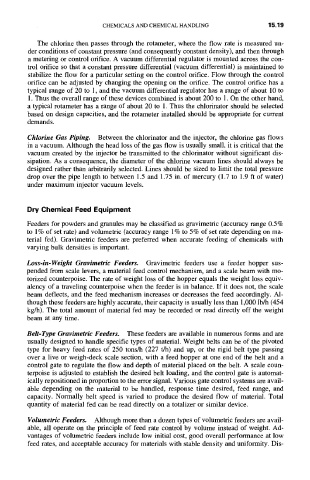Page 511 -
P. 511
CHEMICALS AND CHEMICAL HANDLING 15.19
The chlorine then passes through the rotameter, where the flow rate is measured un-
der conditions of constant pressure (and consequently constant density), and then through
a metering or control orifice. A vacuum differential regulator is mounted across the con-
trol orifice so that a constant pressure differential (vacuum differential) is maintained to
stabilize the flow for a particular setting on the control orifice. Flow through the control
orifice can be adjusted by changing the opening on the orifice. The control orifice has a
typical range of 20 to 1, and the vacuum differential regulator has a range of about 10 to
1. Thus the overall range of these devices combined is about 200 to 1. On the other hand,
a typical rotameter has a range of about 20 to 1. Thus the chlorinator should be selected
based on design capacities, and the rotameter installed should be appropriate for current
demands.
Chlorine Gas Piping. Between the chlorinator and the injector, the chlorine gas flows
in a vacuum. Although the head loss of the gas flow is usually small, it is critical that the
vacuum created by the injector be transmitted to the chlorinator without significant dis-
sipation. As a consequence, the diameter of the chlorine vacuum lines should always be
designed rather than arbitrarily selected. Lines should be sized to limit the total pressure
drop over the pipe length to between 1.5 and 1.75 in. of mercury (1.7 to 1.9 ft of water)
under maximum injector vacuum levels.
Dry Chemical Feed Equipment
Feeders for powders and granules may be classified as gravimetric (accuracy range 0.5%
to 1% of set rate) and volumetric (accuracy range 1% to 5% of set rate depending on ma-
terial fed). Gravimetric feeders are preferred when accurate feeding of chemicals with
varying bulk densities is important.
Loss-in-Weight Gravimetric Feeders. Gravimetric feeders use a feeder hopper sus-
pended from scale levers, a material feed control mechanism, and a scale beam with mo-
torized counterpoise. The rate of weight loss of the hopper equals the weight loss equiv-
alency of a traveling counterpoise when the feeder is in balance. If it does not, the scale
beam deflects, and the feed mechanism increases or decreases the feed accordingly. Al-
though these feeders are highly accurate, their capacity is usually less than 1,000 lb/h (454
kg/h). The total amount of material fed may be recorded or read directly off the weight
beam at any time.
Belt-Type Gravimetric Feeders. These feeders are available in numerous forms and are
usually designed to handle specific types of material. Weight belts can be of the pivoted
type for heavy feed rates of 250 tons/h (227 t/h) and up, or the rigid belt type passing
over a live or weigh-deck scale section, with a feed hopper at one end of the belt and a
control gate to regulate the flow and depth of material placed on the belt. A scale coun-
terpoise is adjusted to establish the desired belt loading, and the control gate is automat-
ically repositioned in proportion to the error signal. Various gate control systems are avail-
able depending on the material to be handled, response time desired, feed range, and
capacity. Normally belt speed is varied to produce the desired flow of material. Total
quantity of material fed can be read directly on a totalizer or similar device.
Volumetric Feeders. Although more than a dozen types of volumetric feeders are avail-
able, all operate on the principle of feed rate control by volume instead of weight. Ad-
vantages of volumetric feeders include low initial cost, good overall performance at low
feed rates, and acceptable accuracy for materials with stable density and uniformity. Dis-

